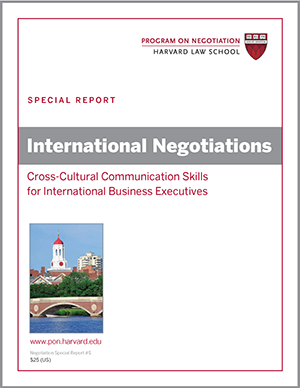
Hard bargaining in negotiation is often touted as the best way to get what you want when all else fails. But as recent news stories illustrate, hard bargaining often backfires unless used in tandem with more collaborative strategies.
Hard bargaining in negotiation—including “take it or leave it” offers, threats, and ultimatums—remains widespread. Hard-bargaining tactics often backfire and harm relationships, however. Two recent negotiations in the news illustrate different approaches to hard-bargaining tactics—and what you can learn from them.
A Hard-Bargaining Approach Collapses at the Finish Line
As cities like New York and Chicago have struggled to cope with a steady flow of migrants from the U.S. southern border, Congress and U.S. president Joe Biden have faced pressure to address the crisis. In fall 2023, congressional Republicans presented Democrats with an ultimatum: Negotiate a border-security plan in exchange for funding for Ukraine and Israel.
Like many cases of hard bargaining in negotiation, the gambit garnered attention. A bipartisan trio of senators—Republican James Lankford of Oklahoma, independent Kyrsten Sinema of Arizona, and Democrat Chris Murphy of Connecticut—came together to try to hash out a border deal, the Wall Street Journal reports.
The negotiations lasted many months and were reportedly conducted in good faith. But as the talks dragged on, opposition brewed among Republicans. On the campaign trail, former president Donald Trump began “warning his followers that they were being sold out” on immigration, the Journal reports. According to Lankford, a “popular commentator” warned him that he would “do whatever I can to destroy you” if he advanced a bill that solved the border crisis during the presidential election, according to the Journal.
Soon other immigration hawks and Republican leaders were withdrawing their support for a border security bill. “Absolutely not,” House Speaker Mike Johnson posted on social media of a reported deal in January 2024.
On February 3, Lankford, Murphy, and Sinema released a $118.3 billion emergency national security bill that included $60.1 billion in military assistance for Ukraine, $14.1 billion in security assistance for Israel, $10 billion for global humanitarian aid, and about $20 billion in border investments, the New York Times reports. Taking a much tougher stance than past proposals, the bill would have effectively closed the border to unauthorized migrants and offered little relief to undocumented immigrants.
But despite largely meeting the prior stipulations of Senate Republicans, the Lankford-Murphy-Sinema bill proved dead on arrival. In a meeting of Senate Republicans, hard-liners made it clear they would not vote for the bill. That led former supporters, such as Minority Leader Mitch McConnell, to back away from it. The bill ended up getting just four Republican votes and died in the Senate.
The about-face exposed fractures in the Republican party, leaving them with “none of what they sought and opening them to accusations of cynical political gamesmanship,” according to the Journal. As the story illustrates, because hard bargaining shows little flexibility, it can be prone to failure—in this case, because a coalition collapsed and parties reneged on their promises.
Hard Bargaining in Negotiation: Good Cop, Bad Cop
Now let’s consider another recent political story involving hard bargaining in negotiation. At an emergency summit in January 2024, European Union (E.U.) leaders were eager to pass a 50 billion euro fund to support the economy of war-torn Ukraine for the next four years. There was just one obstacle: Hungarian prime minister Viktor Orbán, the only E.U. leader out of 27 who refused to vote for the plan.
Unanimity was required to pass the deal, but Orbán, Russian president Vladimir Putin’s closest E.U. ally, was determined not to give away his vote for free, the Times reports: He demanded an annual opportunity to veto the disbursement of money to Ukraine. Orbán has long been at odds with other E.U. leaders over antidemocratic policies in Hungary. In fact, the E.U. had blocked Hungary from accessing about 20 billion euros until he could prove its policies accord with E.U. rules and values.
European leaders took a “divide and conquer” approach to winning over Orbán during the summit. “European Council President Charles Michel played the bad cop,” the Times reports. That involved letting him know he would not get veto rights over the Ukraine fund and, further, that the so-called “nuclear option” was on the table—the E.U.’s ability to remove his vote entirely.
The part of the “good cop” was played by Italian prime minister Giorgia Meloni, who shares Orbán’s hard-right ideology. Over champagne, Meloni tried to convince Orbán he had more to gain from the E.U. if he voted for the fund. Then French president Emmanuel Macron suggested to Orbán that he and the other leaders might be willing to acknowledge Orbán’s complaint that the E.U. has been “withholding funds from Hungary because of ideological bias,” according to the Times.
Next, back to the bad cops: Other leaders sent the message that Orbán would be granted no further concessions. He was “forced to fold,” the Times reports. The fund passed with his support.
For Orbán, it was a failed case of hard bargaining in negotiation. More interesting was the good cop, bad cop approach of other E.U. leaders, who combined efforts at win-win negotiation with hard bargaining in negotiation. It’s a tactic that business negotiators might consider imitating when trying to win the support of a recalcitrant opponent.
What have your experiences with hard bargaining in negotiation been like?





